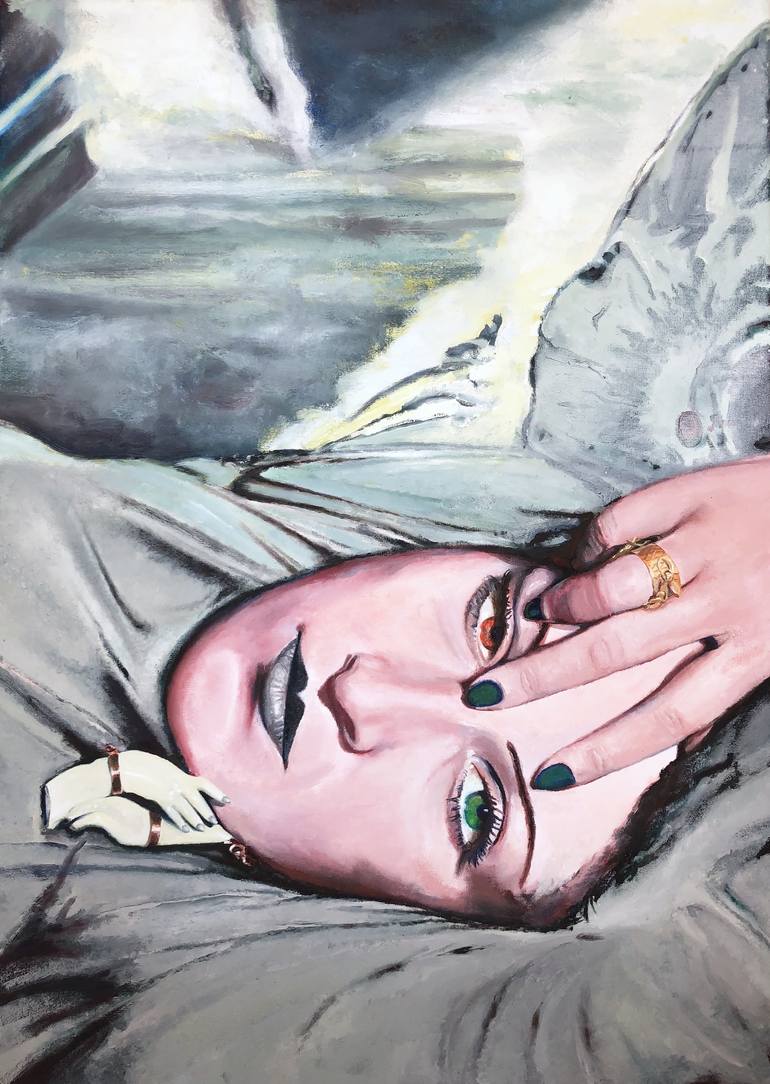







VIEW IN MY ROOM
Dora Maar (after Man Ray, 1936) Painting
Switzerland
Painting, Oil on Canvas
Size: 19.7 W x 27.6 H x 1.6 D in
Ships in a Box
Shipping included
14-day satisfaction guarantee
Artist Recognition

Artist featured in a collection
About The Artwork
Dora Maar (after Man Ray, 1936) Oil on canvas with homemade white linen wooden box frame (50 x 70 cm, 58 x 78 cm with frame). Dora Maar was a photographer, a painter and a poet. She met Picasso in Paris in 1936 and became her muse and lover. Picasso made a portrait of Dora in 1937, with one red eye and one pale green eye. According to different sources, her eyes were 'pale blue' or 'bronze green'. Artists have two eyes: one turned to the inside, and the other open to the world, and I also choose red and green – this time a vivid combination of emerald and cadmium green light. The painting is part of my 'B&W Color' project initiated in 2016, as a tribute to surrealist photographers and collagists Man Ray, Claude Cahun, Jindřich Štyrský, Toshiko Okanoue and others. The reinterpretation of the original black and white works using oil-based pigments and glazing fundamentally alters their poetic and often enigmatic character. Here color layers bring their own vibrations and depth and thus radically change the emotion. The process is a slow maturation, in contrast with digital colorization. Like the slow change of colors throughout seasons: Palissade peinte Les arbres verts sont tout roses Voilà ma saison (Paul Éluard, onze haï-kaïs, 1920) Acknowledgements to E. Llach for her intuition when experimenting with colors. Lausanne, Switzerland, May 2018. The date and artist's signature are on the back.
Details & Dimensions
Painting:Oil on Canvas
Original:One-of-a-kind Artwork
Size:19.7 W x 27.6 H x 1.6 D in
Frame:White
Ready to Hang:Not applicable
Packaging:Ships in a Box
Shipping & Returns
Delivery Time:Typically 5-7 business days for domestic shipments, 10-14 business days for international shipments.
Handling:Ships in a box. Artists are responsible for packaging and adhering to Saatchi Art’s packaging guidelines.
Ships From:Switzerland.
Have additional questions?
Please visit our help section or contact us.
Switzerland
I was born in Nancy, France in 1964 and lived in the United States. I came to Lausanne, Switzerland in the 90s where I live and work as a researcher in materials science, spending increasing time in Japan since 2022. I have always been drawing and I create oil paintings in the footsteps of my maternal grandfather. I have the privilege to work since many years in Elisabeth Llach's workshop "I prefer what touches me to what surprises me". These words are from the XVIII century French harpsichorist and composer François Couperin, which I reuse here as they beautifully apply to the work of painting, like the gradual change of colors over the seasons: Painted palisade The green trees are all pink This is my season (Paul Eluard, eleven hai-kais, 1920) My work is a tribute to the long-standing friendship and artistic complicity between France and Japan. I reinterpret works from the 16th to the 20th centuries, making preparatory collages combining ‘ukiyo’ landscapes and characters from both cultures and from all eras. The titles of the paintings are inspired by readings of French surrealist poems and translated into Japanese ... or vice versa. Since 2010 I started to create enigmatic collages, whose titles are taken from surrealist poems. My approach is inspired by the automatic writing dear to Breton and Soupault and the observation of nature so beautiful and so definitely strange, ultimate enigma! I combine traditional collage, namely cutting and assembling prints using acrylic binders, with digital cutting and image processing techniques. Sometimes I add painted elements, preferably using gouache. One of my collages is a tribute to Swiss surrealist artist and photographer Meret Oppenheim: she comes out of a cup, she wears a fur tie and her left eye is masked by a teaspoon. The fur tie is inspired by a work by Mimi Parent. The cup, spoon and tie are also reminiscent of Meret's famous work entitled 'The Fur Luncheon' which is a fur-covered coffee service. All this construction is purely intellectual. But the idea of the hidden eye is on the contrary spontaneous, and came to me once the was collage finished. Its hidden meaning is that unlike most people, artists have two eyes: one turned towards the world, and one turned inward. My artworks have been acquired by private collectors in Switzerland, France, USA, Chile and Japan. Thanks to Elisabeth-sama for her intuition in experimenting with colors and to Masako-sama for complicity and inspiration.
Artist Recognition

Artist featured by Saatchi Art in a collection
Thousands Of Five-Star Reviews
We deliver world-class customer service to all of our art buyers.
Global Selection
Explore an unparalleled artwork selection by artists from around the world.
Satisfaction Guaranteed
Our 14-day satisfaction guarantee allows you to buy with confidence.
Support An Artist With Every Purchase
We pay our artists more on every sale than other galleries.
Need More Help?